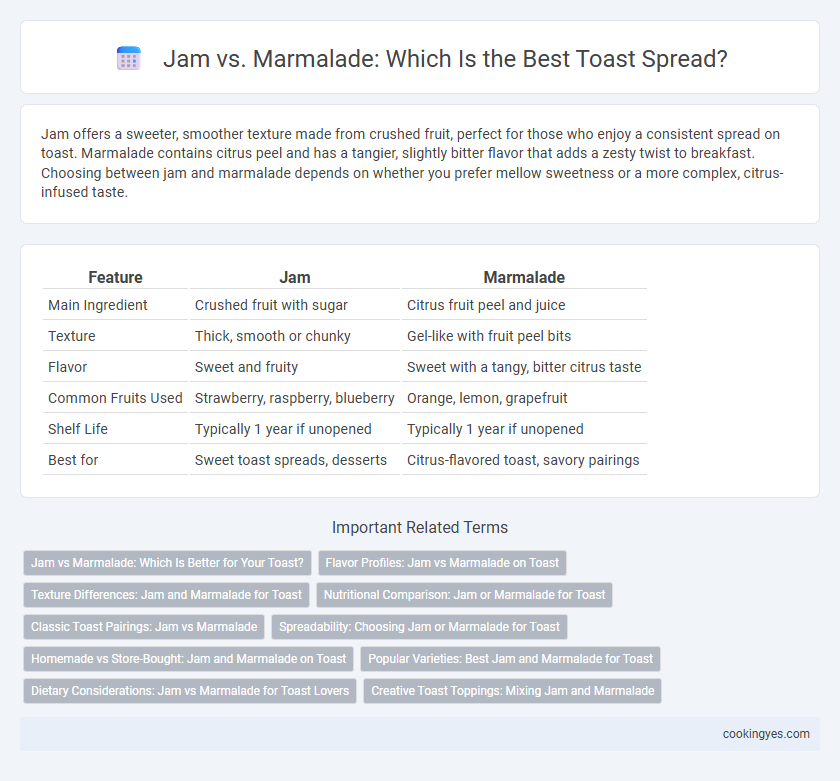Jam offers a sweeter, smoother texture made from crushed fruit, perfect for those who enjoy a consistent spread on toast. Marmalade contains citrus peel and has a tangier, slightly bitter flavor that adds a zesty twist to breakfast. Choosing between jam and marmalade depends on whether you prefer mellow sweetness or a more complex, citrus-infused taste.
Table of Comparison
| Feature | Jam | Marmalade |
|---|---|---|
| Main Ingredient | Crushed fruit with sugar | Citrus fruit peel and juice |
| Texture | Thick, smooth or chunky | Gel-like with fruit peel bits |
| Flavor | Sweet and fruity | Sweet with a tangy, bitter citrus taste |
| Common Fruits Used | Strawberry, raspberry, blueberry | Orange, lemon, grapefruit |
| Shelf Life | Typically 1 year if unopened | Typically 1 year if unopened |
| Best for | Sweet toast spreads, desserts | Citrus-flavored toast, savory pairings |
Jam vs Marmalade: Which Is Better for Your Toast?
Jam offers a sweeter, smoother texture with crushed fruit pieces, ideal for those who prefer a rich fruit flavor on toast. Marmalade contains citrus peel and has a slightly bitter, tangy taste that enhances toast with a more complex, zesty profile. Choosing between jam and marmalade depends on whether you want a sugary, fruity spread or a bold, citrus-infused option for your breakfast.
Flavor Profiles: Jam vs Marmalade on Toast
Jam offers a sweet and often more intensely fruity flavor, made from crushed or pureed fruit that retains a thick, spreadable texture perfect for enhancing the softness of toast. Marmalade features a bittersweet taste derived from citrus fruits, particularly oranges, with the inclusion of zesty peel slices that add a slightly bitter crunch and a vibrant tang. Choosing between jam and marmalade depends on the preferred flavor balance: jam emphasizes rich sweetness and smoothness, while marmalade provides a bright, citrusy contrast that cuts through the bread's mildness.
Texture Differences: Jam and Marmalade for Toast
Jam has a smooth yet slightly chunky texture due to crushed fruit pieces, offering a thick and spreadable consistency that easily melts into toast. Marmalade contains translucent citrus peel strips suspended in a gel-like base, providing a chewy contrast and a firmer texture compared to jam. These texture differences influence mouthfeel and spreadability, with jam delivering a softer, more uniform layer and marmalade offering a zesty, textured bite on toast.
Nutritional Comparison: Jam or Marmalade for Toast
Jam and marmalade differ significantly in their nutritional profiles, affecting their suitability as a toast spread. Jam, typically made from crushed fruits and sugar, tends to have higher sugar content and slightly more calories per serving compared to marmalade, which is made from citrus fruit peels and juice, offering a tangier flavor with fewer calories and more fiber. Choosing marmalade can provide a lower-sugar option with added dietary fiber, while jam offers a sweeter taste but with increased sugar intake.
Classic Toast Pairings: Jam vs Marmalade
Classic toast pairings highlight jam's sweet, fruity consistency, offering flavors like strawberry, raspberry, and blueberry that complement buttery toast perfectly. Marmalade features a distinctive citrus zing from orange or lemon peels, providing a bittersweet contrast that enhances plain or seeded bread. Both spreads deliver unique taste profiles, making jam ideal for creamy richness and marmalade a refreshing, tangy option.
Spreadability: Choosing Jam or Marmalade for Toast
Jam offers a smoother, more uniform spread due to its softer fruit consistency, making it ideal for quick, even application on toast. Marmalade contains citrus peel pieces that provide a thicker texture, resulting in a chunkier spread that may require more effort to distribute evenly. Both spreads enhance toast flavor, but jam's spreadability suits those seeking convenience and ease.
Homemade vs Store-Bought: Jam and Marmalade on Toast
Homemade jam and marmalade offer richer, more natural flavors and customizable sweetness levels compared to store-bought varieties, which often contain preservatives and added sugars. Jam typically uses crushed fruits, delivering a thicker texture ideal for spreading on toast, while marmalade incorporates citrus peel, providing a tangy contrast perfect for balancing toast's blandness. Choosing homemade not only enhances taste but also ensures control over ingredients, promoting a healthier breakfast option.
Popular Varieties: Best Jam and Marmalade for Toast
Strawberry jam and raspberry jam are among the most popular varieties, offering a sweet and tangy flavor that complements toast perfectly. Seville orange marmalade stands out as a classic choice for marmalade lovers, providing a slightly bitter, citrusy taste ideal for balancing the richness of buttered toast. Blueberry jam and lemon marmalade also rank highly for their vibrant flavors and smooth textures, making them excellent options to enhance your morning toast experience.
Dietary Considerations: Jam vs Marmalade for Toast Lovers
Jam and marmalade differ significantly in sugar content and fruit composition, affecting dietary choices for toast lovers. Jam, made from crushed fruits and sugar, often contains higher sugar levels and may include added pectin or preservatives, impacting calorie intake and glycemic response. Marmalade, typically crafted from citrus fruits like oranges and lemons, offers a slightly lower sugar profile and contains dietary fiber from citrus peels, which can aid digestion and provide antioxidants beneficial for health-conscious consumers.
Creative Toast Toppings: Mixing Jam and Marmalade
Combining jam and marmalade on toast creates a balanced burst of sweetness and citrusy tang, enhancing flavor complexity. Strawberry jam pairs well with orange marmalade, offering a delightful contrast that elevates the toast experience. This mix provides a unique texture blend, merging the smooth richness of jam with the chunky zest of marmalade, perfect for creative breakfast spreads.
Jam vs Marmalade for Toast Spread Infographic

 cookingyes.com
cookingyes.com